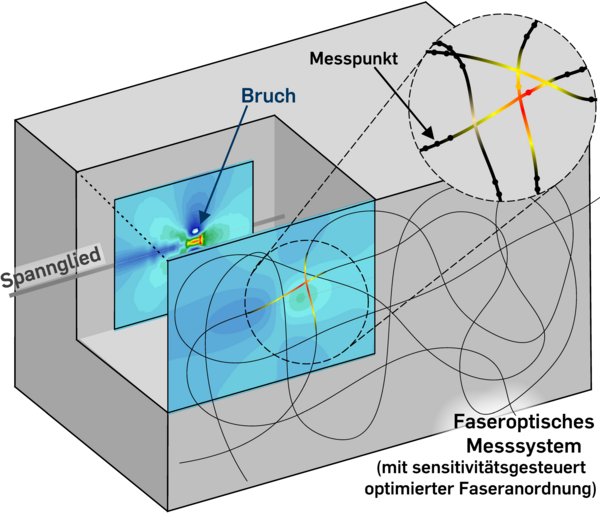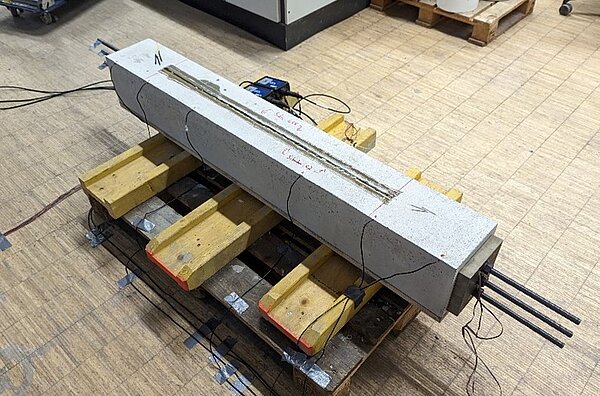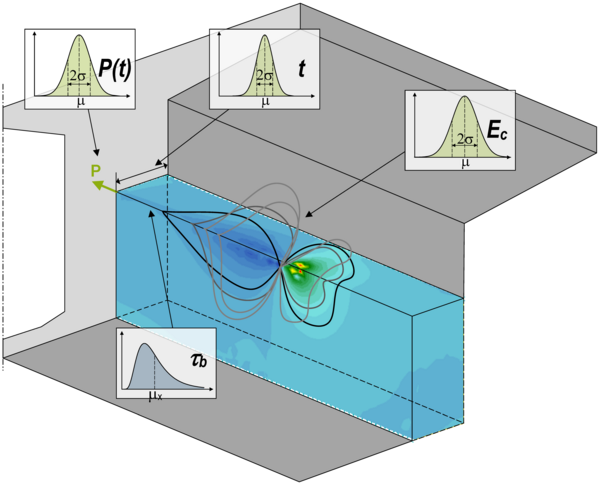Pattern detection of internal prestressing wire breaks on concrete surfaces
All over the world, infrastructure, and bridges in particular, are getting on in years. A wide variety of damage mechanisms and increasing loads have taken their toll. Individuality, sustainability and economic viability require careful consideration of their maintenance or necessary replacement in each individual case. Such decisions are based on recalculations and increasingly on structural health monitoring. The latter claims to always announce impending failure in good time; in reinforced concrete construction through the nowadays established criterion of "crack before failure", which is often not fulfilled in existing structures.
Imminent brittle failure, for example due to unnoticed tendon rupture, places special demands on this, which are only inadequately met by current methods such as acoustic emission or coda-wave interferometry. Monitoring must be global, i.e. it must monitor the entire bridge. At the same time, it must be robust and selective with respect to real environmental conditions, noise or a (temporary) failure of the measurement technology. The sensor network must be dense and sensitive in order to provide precise information about the condition.
The highest precision is provided by direct measurements of structural quantities, such as strains. However, the view inside is obstructed, and waiting for a visible crack formation is not an option. This is where the research project starts.
The aim is to detect even small internal damages by permanent two-dimensional strain measurements on the concrete surface - long before a crack becomes visible. As an "improved eye of structural inspection", the system detects discontinuous strain fields caused by wire rupture based on characteristic patterns at any damage location and with low intensity. Crossed fiber-optic sensors are used to record the strain patterns of the rupture and a re-anchoring quasi-continuously. Optimized measurement configurations in terms of frequency, fiber arrangement and distributions make the smallest strain changes usable and specify requirements for data storage and formats.
In consecutive experiments on small and large scales and corresponding stochastic finite element simulations, the rupture and the propagation of the strain fields induced by it are systematically analyzed.
Material- or damage-related uncertainties are included in Monte Carlo simulations and are evaluated with sensitivity analyses with regard to their effects on the measurement result. The core is an automated preparation and differentiation of the characteristic patterns from those of external disturbances, ambient influences or traffic with procedures of pattern recognition and discriminant analysis, which simultaneously allow the discriminatory power to be evaluated. The conceptual transfer to the demonstrator bridge shows and evaluates the feasibility on a large scale, taking into account practical construction conditions and constraints.
Successful completion of the test series for fiber optic detection of tendon breaks
On six prestressed concrete beams (2.0 ∙ 0.3 ∙ 0.2 [m³]), tendon breaks were generated and detected from the concrete surface using a fiber optical grid. In addition to varying material parameters and tendon types, external disturbance variables were also introduced in a targeted manner. Structural mechanical properties were recorded in form of strain changes using a two-dimensional measuring grid of distributed fiber-optical sensors (DFOS). The results show the general suitability of DFOS for the detection of tendon breaks and allow to draw conclusions about the influencing variables relevant for detection. Using DFOS on the external concrete surface, it was possible to detect, localize and quantify the internal damage in all tests by means of external measurements.
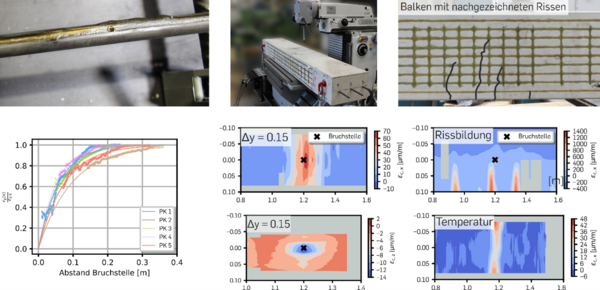
Recalculation of the test series using the finite element method
Computational models of the specimens were created using the finite element method. A tendon failure was simulated by adjusting the boundary conditions and the results obtained were compared with those of the experimental tests. An evaluation of the model quality based on the mean deviation b and its variance Vδ shows good agreement between the computational model and the experiment. The results obtained are subsequently used to investigate tendon breaks on structures on a real scale.
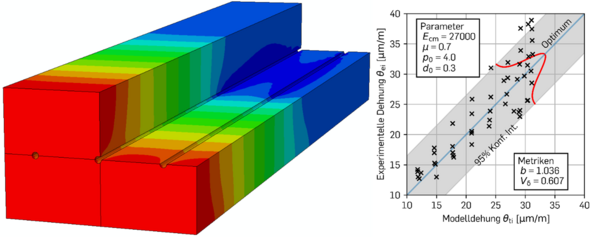
Large-scale test on tendon failure with of a post-tensioned girder in collaboration with the CODA research group (FOR 2825)
The fiber-optic measuring system was tested on a large scale in a test on a post-tensioned concrete slab beam (L = 7.4 m). Under mechanical stress (4-point bending test), strands were specifically damaged to simulate tendon breaks. The DFOS measurement was accompanied by digital image correlation (DIC) and ultrasound-based code wave interferometry. The results provide insights into the influence of the tendon type and large-scale boundary conditions on the measurement signal and detection.
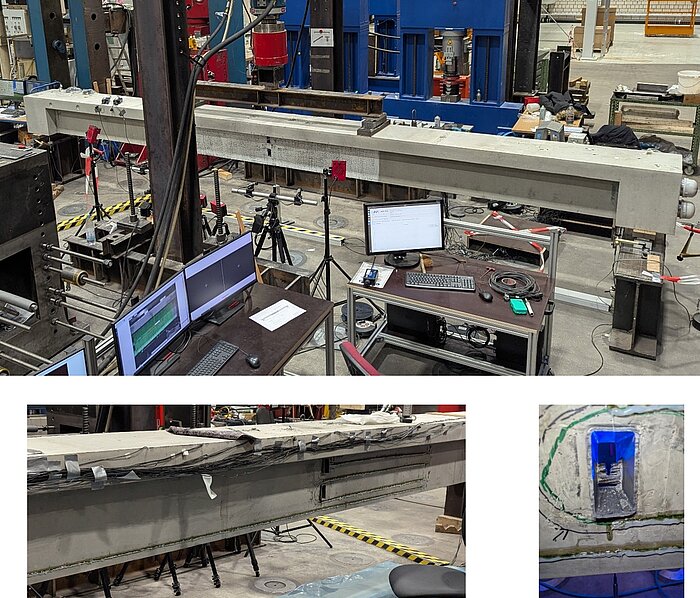
Numerical computation of tendon break on real-sized cross-sections
Based on the calibration of the calculation models, an upscaling towards the dimensions of real prestressed concrete structures was carried out. For this purpose, a cross-section of a box girder based on the dimensions of the Nibelungen Bridge was used. By varying the boundary conditions, the bond-, prestressing- and material- parameters, their influence on the strain field is investigated. The limitations of the measurement method are determined by calculating the corresponding response surfaces.
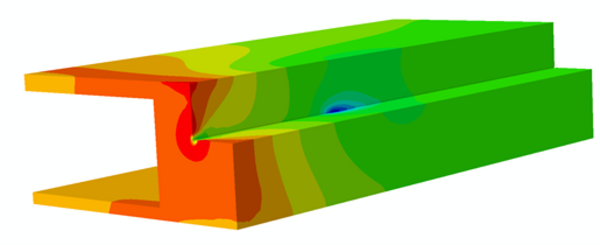
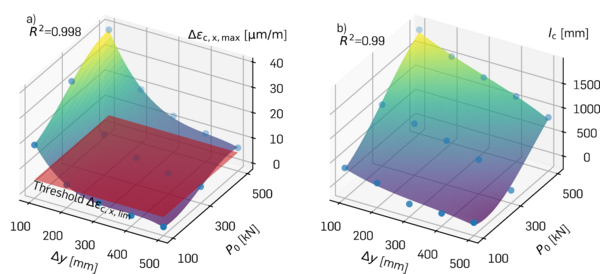
Contact
Publications
Peer-Reviewed Journal Paper
Paul, A.; Sanio, D.; Mark, P. (2025): Detektion innerer Spanndrahtbrüche durch faseroptische Messungen an Betonoberflächen. In: Beton und Stahlbetonbau (doi: 10.1002/best.202400100).
Conferences and other publications
Paul, A.; Sanio, D.; Mark, P. (2024): Monitoring tendon breaks in concrete structures at different depths using distributed fiber optical sensors. e-Journal of Nondestructive Testing 29(7), S. 1-10 (doi: 10.58286/29598).
Paul, A.; Sanio, D.; Mark, P. (2024): Detection of internal tendon breaks by fiber-optical measurements – influence of the re-anchoring behavior. Procedia Structural Integrity 64, S. 1287-1294 (doi: 10.1016/j.prostr.2024.09.199).
Straeter N.; Paul, A.; Clauß, F.; Ahrens, M; Mark P. (2024): Detecting non-visible tendon breaks – a new approach using coda wave interferometry. In: ReConStruct: Resilient Concrete Structures: Proceedings of the 2024 fib Symposium. Henry, R. S. & Palermo, A. (Eds.), 11.-13. November 2024, Christchurch, New Zealand, pp. 283-291.



